Return to Tacloban six months after Haiyan
- Published
When I last saw Tacloban, six months ago, it was from the window of a helicopter. That was the only way to get out, and the relief at doing so was immense.
The city lay ravaged beneath us as we climbed to the west. The week I had just spent there after Typhoon Haiyan had been exhausting. Nearly every house had lost its roof, staying dry was all but impossible. Food was in short supply, dead bodies lined the streets.
This time, I descend the steps of a Philippine Airlines A320 at Tacloban airport. The plane is packed with families, aid workers, even a few tourists. Looking across, I can see the shiny new roof on the airport terminal building.
But the appearance of normality is deceptive. Inside the terminal is still a bare shell. And beyond it the people of Tacloban are still barely recovering.
Everywhere I go people are incredibly welcoming, all the more when I tell them I was here right after the storm. But there is also a deep melancholia. How many died in November's massive typhoon is a highly contentious issue. The government says just over 6,000. People here think it is much higher.
Where their house used to stand next to the beach, Glenda Cruz and her family are celebrating her son Irwin's 31st birthday. But Irwin is not here, nor is his brother Hector, nor his father Frank. Large black and white photos of the men stand amid the ruins. All three were drowned by the huge wave that destroyed their house.
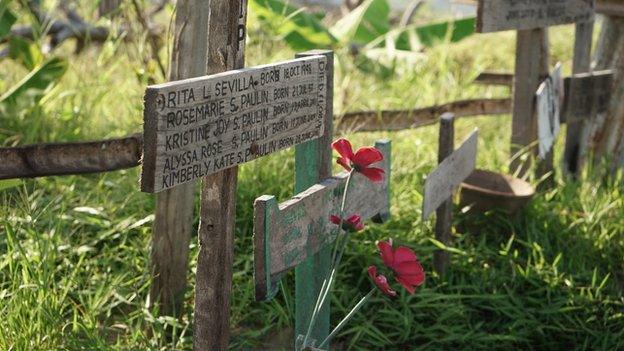
Some families lost several members to the powerful typhoon
Struggling to hold back tears, Glenda tells me she wants this to be a happy day, to celebrate the three men she loved so much and now will never see again.
A little further down the beach I walk past a basketball court. The last time I passed here it was a temporary morgue filled with bodies. The stench was overwhelming.
Now I am grateful to see a group of children laughing and jumping.
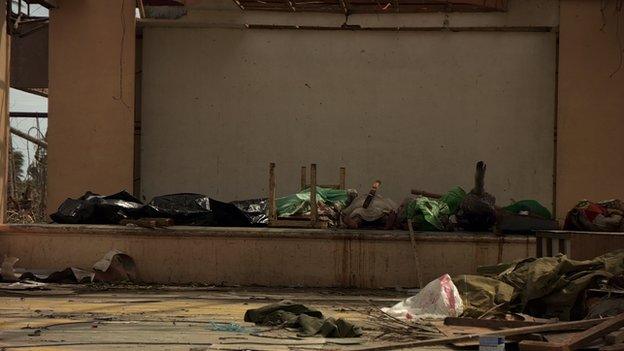
Pictured after the storm, the basketball court was used as a temporary morgue
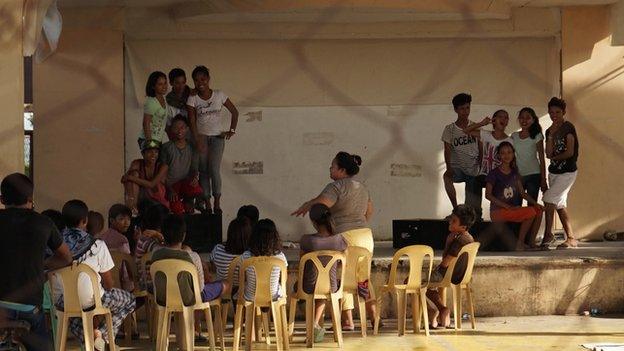
Now, six months on, residents and children are able to use it once again
In a coconut grove behind the basketball court stands the little house owned by Gil Padilla. When I saw Gil last he was trying to get his wife Helen's body out from under a fallen coconut tree.
Gil greets me like a long lost friend, a huge smile beneath his crooked glasses. Things are much better, he says, he is back at work and slowly buying the materials to repair the house. Some of the windows even have glass in them.
But as soon as I ask about Helen, Gil's face turns pensive. He stares into the distance, unable to talk. He refuses to accompany me as I walk round the back of the house to pay my respects at Helen's grave.
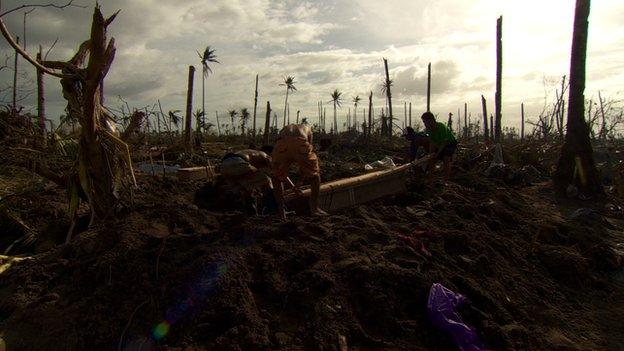
Most of those who died in Tacloban six months ago were buried in mass graves
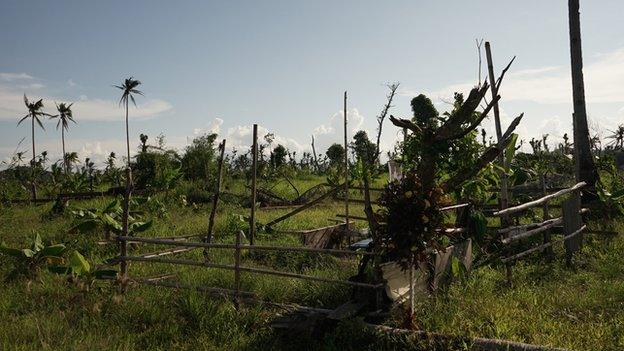
Now, local residents must deal with their grief as they try to rebuild their lives
"If I go there I just start to cry every time", he tells me.
Gil's eldest son Bon is also struggling with the loss of his mother. He doesn't want to cry, he tells me. He has to be strong for his younger brothers who now have no mother to take care of them.
There is a lot of suppressed grief in Tacloban and an enormous amount of trauma that needs to be treated. And it is not just those who have lost family members who are suffering.
Gil's sister, Aida, lost her her livelihood.
When the storm surge swept up the Leyte gulf and into Tacloban, it swept right into Aida's printing shop.
She shows me the huge newspaper printing press she managed to buy second-hand 10 years ago. Now its delicate gears and pulleys are rusted solid. It will never run again.
She too, struggles to hold back tears. Like almost everybody here Aida had no insurance. The bank has refused her a new loan because she now has no collateral. The government meanwhile is insisting she go on paying tax on a business that is making no money.
The people of Tacloban are getting help. Everywhere you go in the city there are large billboards proclaiming the names of the countries and agencies that have given money.
Like every other disaster zone, there are rows of shiny white Toyota SUVs - the preferred transport of every respectable NGO and UN agency.
The few hotels that are operational are full with expatriates, so are the nicer restaurants. It is easy to be cynical about what some call "the misery industry". But there is a lot of good work going on here.
When the huge storm swept in, as many as 25,000 fishing boats were damaged or destroyed.
In a neighbourhood near Tacloban airport the British NGO Oxfam is putting the fishermen back to work. Some are being paid to clear debris. Others are building new boats.
Their old boats were made of wood. But 20,000 new boats all made from wood means cutting down a lot of forest. So Oxfam is teaching the fishermen to build the new boats from fibreglass.
The man running the project, Neil Pancipanci, is also a local. "We are teaching new skills and bringing in new technology," he tells me. "These boats are stronger and will last much longer than wood, at least 20 years."
Some NGOs are building temporary housing, others schools. Some are helping farmers with new seed and fertiliser.
There are NGOs specialising in trauma counselling. They are all desperately needed.
Other signs are less encouraging. Back in November the Philippine government was widely criticised for its snail-like response to the disaster.
Now six months on we hear the same complaint. "The government is doing nothing."
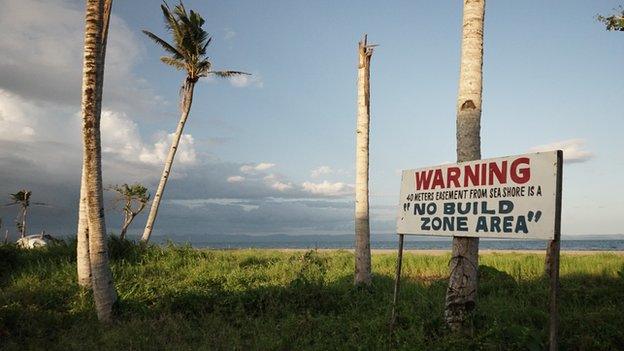
The government has put up signs along the coast to prevent construction near the shoreline
That is not entirely true. All along the coast it has put up large signs forbidding any construction within 40m of the shoreline. This is to protect against another storm surge.
But people are ignoring the sign and building right back up to the shore - or even on stilts over the water.
I ask why they are ignoring the new rule. "The government promised us land to build on away from the coast," they say, "but nothing happens, so we have no choice but to come back here."